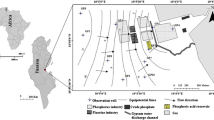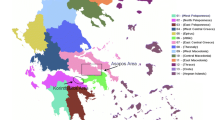Abstract
A large-scale groundwater contamination characterises the Pleistocene groundwater system of the former industrial and abandoned mining region Bitterfeld/Wolfen, Eastern Germany. For more than a century, local chemical production and extensive lignite mining caused a complex contaminant release from local production areas and related dump sites. Today, organic pollutants (mainly organochlorines) are present in all compartments of the environment at high concentration levels. An integrated methodology for characterising the current situation of pollution as well as the future fate development of hazardous substances is highly required to decide on further management and remediation strategies. Data analyses have been performed on regional groundwater monitoring data from about 10 years, containing approximately 3,500 samples, and up to 180 individual organic parameters from almost 250 observation wells. Run-off measurements as well as water samples were taken biweekly from local creeks during a period of 18 months. A kriging interpolation procedure was applied on groundwater analytics to generate continuous distribution patterns of the nodal contaminant samples. High-resolution geological 3-D modelling serves as a database for a regional 3-D groundwater flow model. Simulation results support the future fate assessment of contaminants. A first conceptual model of the contamination has been developed to characterise the contamination in regional surface waters and groundwater. A reliable explanation of the variant hexachlorocyclohexane (HCH) occurrence within the two local aquifer systems has been derived from the regionalised distribution patterns. Simulation results from groundwater flow modelling provide a better understanding of the future pollutant migration paths and support the overall site characterisation. The presented case study indicates that an integrated assessment of large-scale groundwater contaminations often needs more data than only from local groundwater monitoring. The developed methodology is appropriate to assess POP-contaminated mega-sites including, e.g. HCH deposits. Although HCH isomers are relevant groundwater pollutants at this site, further organochlorine pollutants are present at considerably higher levels. The study demonstrates that an effective evaluation of the current situation of contamination as well as of the related future fate development requires detailed information of the entire observed system.


Similar content being viewed by others
Notes
The term “lindane” should be distinguished from γ-HCH; γ-HCH is one of several HCH isomers, and is a component of technical HCH as well as of lindane. Lindane contains 99 % of pure γ-HCH.
After year 2002, the regional groundwater flow situation changed in consequence of the flooded open pit mine Goitzsche and caused therewith an adjustment of the local site management.
References
Abhilash PC, Singh N (2009) Seasonal variation of HCH isomers in open soil and plant-rhizospheric soil system of a contaminated environment. Environ Sci Pollut Res 16:727–740
Chemie AG Bitterfeld-Wolfen (eds.) (1993) Bitterfelder Chronik. 100 Jahre Chemiestandort Bitterfeld-Wolfen, Eigenverlag, 220
Eichler D (1983) Physikochemische Eigenschaften, Verhalten und Analytik der HCH-Isomere. In: DFG (ed) Hexachlorcyclohexan als Schadstoff in Lebensmitteln. Verlag Chemie, Weinheim, 14–17
German Environmental Agency (UBA) (2005) Stark erhöhte Hexachlorcyclohexan (HCH)-Werte in Fischen aus Mulde und Elbe. August 2005
Gossel W, Stollberg R, Wycisk P (2009) Regionales Langzeitmodell zur Simulation von Grundwasserströmung und Stofftransport im Gebiet der Unteren Mulde/Fuhne. Grundwasser 14(Bd. 1):47–60. doi:10.1007/s00767-008-0096-3
Großmann J, Kerndorff H (2006) Schadstoffaustragsverhalten von Chemiealtablagerungen am Beispiel der Altdeponie “Grube Antonie” in Bitterfeld. Schriftenreihe des Vereins für Wasser-, Boden- und Lufthygiene e.V., Bd. 119, Berlin, 363
Heidrich S, Schirmer M, Weiss H, Wycish P, Grossmann J, Kaschl A (2004) Regionally contaminated aquifers - toxicological relevance and remediation options (Bitterfeld case study). Toxicology 205:143–155.
Heinisch E (1992) Umweltbelastung in Ostdeutschland: Fallbeispiele: chlorierte Kohlenwasserstoffe. Wissenschaftliche Buchgesellschaft, Darmstadt, 297
Jit S, Dadhwal M, Kumari H, Jindal S, Kaur J, Lata P, Niharika N, Lal D, Garg N, Gupta SK, Sharma P, Bala K, Singh A, Vijgen J, Weber R, Lal R (2011) Evaluation of hexachlorocyclohexane contamination from the last lindane production plant operating in India. Environ Sci Pollut Res 18(4):586–597
Kalbitz K, Popp P (1999) Seasonal impacts on β-hexachlorocyclohexane concentration in soil solution. Environ Pollut 106:139–141
Kalbus E, Schmidt C, Molson J, Reinstorf F, Schrimer M (2008) Groundwater–surface water interactions at the contaminated mega-site Bitterfeld, Germany. In GQ07 (eds.) Securing groundwater quality in urban and industrial environments. IAHS Publication, 324, 491–498, ISBN 978-1-901502-79-4
Neumann C (2006) Untersuchungen zur Schadstoffaustragsdynamik aus regional kontaminierten Grundwasserleitern in lokale Vorfluter unter Berücksichtigung der klimatisch-hydrologischen Bezugsgrößen. Projektabschlussbericht UFZ Leipzig-Halle, 115
Paschke H, Popp P (2005) New passive samplers for chlorinated semivolatile organic pollutants in ambient air. Chemosphere 58(7):855–863
Paschke A, Schwab K, Brümmer J, Schüürmann G, Paschke H, Popp P (2006a) Rapid semi-continuous calibration and field test of membrane-enclosed silicone collector as passive water sampler. J Chromatogr A 1124:187–195. doi:10.1016/j.chroma.2006.06.094
Paschke A, Vrana B, Popp P, Schüürmann G (2006b) Comparative application of solid-phase microextraction fibre assemblies and semi-permeable membrane devices as passive air samplers for semi-volatile chlorinated organic compounds. A case study on the landfill “Grube Antonie” in Bitterfeld, Germany. Environ Pollut 144:414–422. doi:10.1016/j.envpol.2005.12.046
Popp P, Brüggemann L, Keil P, Thuss U, Weiss H (2000) Chlorobenzenes and hexachlorocyclohexanes (HCHs) in the atmosphere of Bitterfeld and Leipzig (Germany). Chemosphere 41(6):849–855
Rückert M, Weiss H (2004) Abbauprodukte der in situ-Sanierungsverfahren. In: Weiss H, Teutsch G, Daus B (eds) SAFIRA (Sanierungsforschung in regional kontaminierten Aquiferen), UFZ-Bericht 13/2004. UFZ Leipzig-Halle GmbH, Leipzig, 170–198
Schwartz R, Gerth J, Neumann-Hensel H, Bley S, Förstner U (2006) Assessment of highly polluted fluviosol in the Spittelwasser floodplain—based on national guideline values and MNA-criteria. J Soils Sediment 6(3):145–155. doi:10.1065/jss2006.06.166
Sommerwerk K (2003) Die Recherche der industriehistorischen Entwicklung der Region Bitterfeld-Wolfen als Voraussetzung für ein effektives Umweltmonitoring. In Zabel HU (ed.) Theoretische Grundlagen und Ansätze einer Umweltwirtschaft. Tagungsband 2003, Institut für Betriebswirtschaftslehre, MLU Halle-Wittenberg, 111–130
Steinmetz T (2007) Integration, Analyse und interaktive Visualisierung von Daten für das Risikomanagement großräumig kontaminierter Standorte. Dissertation, Martin-Luther University Halle-Wittenberg, 125
Thieken AH (2002) Schadstoffmuster in der regionalen Grundwasserkontamination der mitteldeutschen Industrie- und Bergbauregion Bitterfeld-Wolfen. Dissertation, Martin-Luther University Halle-Wittenberg, 147
Torres JPM, Fróes-Asmus CIR, Weber R, Vijgen JMH (2010) HCH/DDT contamination around former organochlorine productions in Brazil and preliminary human risk assessment. Organohalogen compounds 72 http://www.xcdtech.com/dioxin2010/pdf/1304.pdf (Accessed 07/02/2011)
Vijgen J (2006) The legacy of lindane HCH isomer production. Main report. IHPA, January 2006 http://ew.eea.europa.eu/Agriculture/Agreports/obsolete_pesticides/lindane_production.pdf (Accessed 21/02/2011)
Vijgen J, Abhilash PC, Li YF, Lal R, Forter M, Torres J, Singh N, Yunus M, Tian C, Schäffer A, Weber R (2010) HCH isomers as new Stockholm Convention POPs—are we on the way to manage lindane (γ-HCH), and waste HCH isomer (α- and β-HCH) pollution around the world? Environ Sci Pollut Res 5:363–393
Vrana B, Paschke H, Paschke A, Popp P, Schüürmann G (2005) Performance of semipermeable membrane devices for sampling of organic contaminants in groundwater. J Environ Monit 7:500–508
Vrana B, Paschke A, Popp P (2006) Calibration and field performance of membrane-enclosed sorptive coating for integrative passive sampling of persistent organic pollutants in water. Environ Pollut 144:296–307. doi:10.1016/j.envpol.2005.11.046
Walkow F, Enders K, Peklo P (2000) The pollution of soil and groundwater in Bitterfeld. In Weiss H, Rijnaarts H, Staps S, Merkel, P (eds.) SAFIRA—UFZ-Bericht, 23/2000, Leipzig, 7–12
Weber R, Gaus C, Tysklind M (2008a) Dioxin—contemporary and future challenges of historical legacies. Environ Sci Pollut Res 15:96–112
Weber R, Gaus C, Tysklind M, Johnston P, Forter M, Hollert H, Heinisch E, Holoubek I, Lloyd-Smith M, Masunaga S, Moccarelli P, Santillo D, Seike N, Symons R, Torres JPM, Verta M, Varbelow G, Vijgen J, Watson A, Costner P, Woelz J, Wycisk P, Zennegg M (2008b) Dioxin- and POP-contaminated sites—contemporary and future relevance and challenges. Environ Sci Pollut Res 15:363–393
Weber R, Watson A, Forter M, Oliaei F (2011) Persistent organic pollutants and landfills—a review of past experiences and future challenges. Waste Manag Res 29(1):107–121
Weiss H, Teutsch G, Fritz P, Daus B, Dahmke A, Grathwohl P, Trabitzsch R, Feist B, Ruske R, Böhme O, Schirmer M (2001) Sanierungsforschung in regional kontaminierten Aquiferen (SAFIRA)—1. Information zum Forschungsschwerpunkt am Standort Bitterfeld. Grundwasser 6(3):113–122
Weiss H, Schirmer M, Teutsch G, Merkel P (2002) Sanierungsforschung in regional kontaminierten Aquiferen (SAFIRA)—2. Projektüberblick und Pilotanlage. Grundwasser 7(3):135–139
Weiss H, Teutsch G, Daus B (2004) SAFIRA—Zusammenfassender Projektbericht. UFZ-Bericht 13/2004, Leipzig, 366
Wölz J, Engwall M, Maletz S, Olsmann H, van Bavel B, Kammann U, Klempt M, Weber R, Braunbeck T, Hollert H (2008) Changes in toxicity and dioxin-like activity of suspended particulate matter during flood events at the rivers Neckar and Rhine. Environ Sci Pollut Res 15:536–553
Wycisk P, Fabritius H, Ruske R, Weiss H (2002) Das digitale geologische Strukturmodell Bitterfeld als neuer Baustein in der Sanierungsforschung. Grundwasser 7(3):165–171
Wycisk P, Weiss H, Kaschl A, Heidrich S, Sommerwerk K (2003) Groundwater pollution and remediation options for multi-source contaminated aquifers (Bitterfeld/Wolfen, Germany). Toxicol Lett 140:343–351
Wycisk P, Neumann Ch, Fleck G, Gossel, W (2004) Ermittlung räumlicher Risikobereiche und Auswirkungen auf die Landnutzung als Grundlage einer maßnahmeorientierten Schadensvorsorge im Bereich Bitterfeld/Wolfen—Risikobereiche und Landnutzung. In Geller W, Ockenfeld K, Böhme M, Knöchel A (eds.) Schadstoffbelastung nach dem Elbe-Hochwasser 2002—Ad-hoc-Projekt Schadstoffuntersuchungen nach dem Hochwasser vom August 2002 zur Ermittlung der Gefährdungspotenziale an Elbe und Mulde, Abschlußbericht des BMBF-Verbundvorhabens, 362–381
Wycisk P, Neumann Ch, Gossel W (2005) Flooding induced effects from the Mining Lake Goitzsche on groundwater and land-use in the Bitterfeld area. Acta Hydrochim Hydrobiol 33(5):507–518
Wycisk P, Hubert T, Gossel W, Neumann Ch (2009) High-resolution 3D spatial modelling of complex geological structures for an environmental risk assessment of abundant mining and industrial mega-sites. Comput Geosci 35(1):165–182. doi:10.1016/j.cageo.2007.09.001
Acknowledgments
Parts of the paper have been founded by the German Federal Ministry of Education and Research (BMBF) as well as by the Federal State Agency of Saxony-Anhalt (LAF) within the SAFIRA and the Ad-Hoc Elbe-Mulde Projects. Furthermore, a partial project funding was added by the Helmholtz Centre for Environmental Research—UFZ.
Author information
Authors and Affiliations
Corresponding author
Additional information
Responsible editor: Michael Matthies
This article belongs to the series “Dioxin and POP Contaminated Sites” edited by Roland Weber, Mats Tysklind, Caroline Gaus (Weber et al. 2008a).
Electronic supplementary material
Below is the link to the electronic supplementary material.
ESM 1
(DOC 1,772 kb)
Rights and permissions
About this article
Cite this article
Wycisk, P., Stollberg, R., Neumann, C. et al. Integrated methodology for assessing the HCH groundwater pollution at the multi-source contaminated mega-site Bitterfeld/Wolfen. Environ Sci Pollut Res 20, 1907–1917 (2013). https://doi.org/10.1007/s11356-012-0963-4
Received:
Accepted:
Published:
Issue Date:
DOI: https://doi.org/10.1007/s11356-012-0963-4




